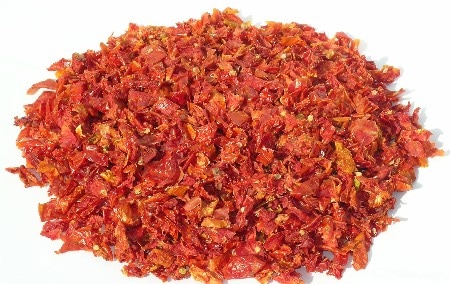think of anything more nourishing with healthy good fiber that acts like a
pre-biotic. Pre-biotics are ingredients that stimulate the growth of good bacteria in the digestive system. Please see below.
nuggets are filled. Some companies use expensive very healthy ingredients
like we do. Example, we use an exceptional chicken meal, our fish meal and
egg offer an excellent protein picture. Some companies will use wheat, or
soy, or corn. They are not fillers. They are lower quality protein.
There are enough negative theories going around. And, the worse part is
that it hurts the animals. Let's talk tomato nutrients:
the deep red color of many tomatoes.
- Tomatoes are widely known for their outstanding antioxidant content,
including, of course, their oftentimes-rich concentration of lycopene.
Researchers have recently found an important connection between lycopene,
its antioxidant properties, and bone health. A study was designed in which
tomato and other dietary sources of lycopene were removed from the diets of
postmenopausal women for a period of 4 weeks, to see what effect lycopene
restriction would have on bone health. At the end of 4 weeks, women in the
study started to show increased signs of oxidative stress in their bones
and unwanted changes in their bone tissue. The study investigators
concluded that removal of lycopene-containing foods (including tomatoes)
from the diet was likely to put women at increased risk of osteoporosis.
They also argued for the importance of tomatoes and other
lycopene-containing foods in the diet. We don't always think about
antioxidant protection as being important for bone health, but it is, and
tomato lycopene (and other tomato antioxidants) may have a special role to
play in this area.
benefits. In terms of conventional antioxidants, tomatoes provide an
excellent amount of vitamin C and beta-carotene; a very good amount of the
mineral manganese; and a good amount of vitamin E. In terms of
phytonutrients, tomatoes are basically off the chart, and include:
- Flavonones
- naringenin
- chalconaringenin
- Flavonols
- rutin
- kaempferol
- quercetin
- Hydroxycinnamic acids
- caffeic acid
- ferulic acid
- coumaric acid
- Carotenoids
- lycopene
- lutein
- zeaxanthin
- beta-carotene
- Glycosides
- esculeoside A
- Fatty acid derivatives
- 9-oxo-octadecadienoic acid
Specific antioxidant nutrients found in tomatoes, whole tomato extracts,
and overall dietary intake of tomatoes have all been associated with
antioxidant protection. Sometimes this protection comes in the form of
reduced lipid peroxidation (oxygen damage to fats in cell membranes or in
the bloodstream). Sometimes this protection comes in the form of better
antioxidant enzyme function (for example, better function of the enzymes
catalase or superoxide dismustase). Better antioxidant protection has also
been shown using broad measurements of oxidative stress in different body
systems. We've seen studies involving tomato and specific antioxidant
protection of the bones, liver, kidneys, and bloodstream.
Reduced risk of heart disease is an area of health benefits in which
tomatoes truly excel. There are two basic lines of research that have
repeatedly linked tomatoes to heart health. The first line of research
involves antioxidant support, and the second line of research involves
regulation of fats in the bloodstream.
No body system has a greater need for antioxidant protection than the
cardiovascular system. The heart and bloodstream are responsible for taking
oxygen breathed in through the lungs and circulating it around throughout
the body. In order to keep this oxygen in check, antioxidant nutrients are
needed in an ample supply.. It's worth noting here that conventional
vitamin antioxidants like vitamin E and vitamin C are sometimes overlooked
in tomatoes because of their unique phytonutrient composition. Yet vitamin
E and vitamin C provide critical antioxidant support in the cardiovascular
system, and they are an important part of the contribution made by tomatoes
to our heart health. It's the carotenoid lycopene, however, that has gotten
the most attention as tomatoes' premier antioxidant and heart-supportive
nutrient. Lycopene (and a related group of nutrients) has the ability to
help lower the risk of lipid peroxidation in the bloodstream. Lipid
peroxidation is a process in which fats that are located in the membranes
of cells lining the bloodstream, or fats that are being carried around in
the blood, get damaged by oxygen. This damage can be repaired if it is kept
at manageable levels. However, chronic and/or excessive lipid peroxidation
in the bloodstream leads to trouble. Overly damaged fat components sound an
alarm to the body's immune and inflammatory systems, and the result is a
series of processes that can lead to a gradual blocking of blood vessels
(atherosclerosis) or other problems.
Many phytonutrients in tomatoes are likely to be involved with the
improvement of our blood fat levels. Two little-known phytonutrients—one
called esculeoside A and the other called 9-oxo-octadecadienoic acid—are
currently under active investigation by researchers as tomato
phytonutrients especially important in blood fat regulation.
Yet another area of increasing interest in tomatoes and heart health
involves blood cells called platelets. The excessive clumping together of
platelet cells can cause problems for our bloodstream in terms of blockage
and unwanted clotting, and prevention of this excessive clumping is
important for maintaining heart health. Numerous phytonutrients in tomatoes
have been shown to help prevent excessive clumping of our platelet cells.
(This ability is usually referred to as an "antiaggregatory effect.") In
combination with the other heart benefits described above, this
platelet-regulating impact of tomatoes puts them in a unique position to
help us optimize our cardiovascular health.











 RSS Feed
RSS Feed




